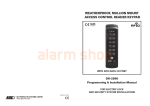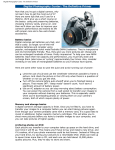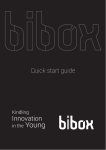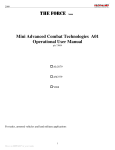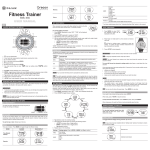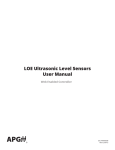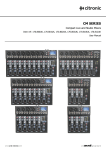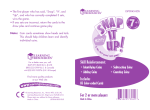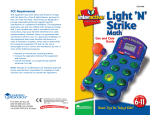Download Teaching Cash Register
Transcript
2690 Cash Reg GUD RVMP2 9/25/07 3:53 PM Page 1 LER 2690 FCC Requirements This equipment has been tested and found to comply with the limits for a Class B digital device, pursuant to Part 15 of the FCC Rules. These limits are designed to provide reasonable protection against harmful interference in a residential installation. This equipment generates, uses and can radiate radio frequency energy and, if not installed and used in accordance with the instructions, may cause harmful interference to radio communications. However, there is no guarantee that interference will not occur in a particular installation. If this equipment does cause harmful interference to radio or television reception, which can be determined by turning the equipment off and on, the user is encouraged to try to correct the interference by one or more of the following measures: ® Use and Care Guide • Reorient or relocate the receiving antenna. • Increase the separation between the equipment and receiver. • Consult the dealer or an experienced radio/TV technician for help. Note: Changes or modifications not expressly approved by the manufacturer responsible for compliance could void the user’s authority to operate the equipment. For a dealer near you, call: (847) 573-8400 (U.S. & Int’l) (800) 222-3909 (U.S. & Canada) +44 (0)1553 762276 (U.K. & Europe) © Learning Resources, Inc., Vernon Hills, IL (U.S.A.) Learning Resources Ltd., King’s Lynn, Norfolk (U.K.) Please retain our address for future reference. Made in China. LPK2690-TG1 Smart Toys for Today’s Kids®! 2690 Cash Reg GUD RVMP2 9/25/07 3:53 PM Page 2 Teaching Cash Register TABLE OF CONTENTS TEACHING CASH REGISTER INFORMATION . . . . . . . . . . . . . . . 1 GETTING STARTED . . . . . . . . . . . . . . . . . . . . . . . . . . . . . . . . . . . . 3 LET’S PLAY! . . . . . . . . . . . . . . . . . . . . . . . . . . . . . . . . . . . . . . . . . . 4 LEARNING ACTIVITIES . . . . . . . . . . . . . . . . . . . . . . . . . . . . . . . . . 6 The Teaching Cash Register is a fun and exciting way for children to explore the concept of money while using their imaginations. This unique educational toy features games and play patterns that familiarize children, from pre-school on up, with the size and value of certain coins. Children will naturally begin learning to add and subtract when they use the Teaching Cash Register for pretend play, as they buy and sell items from their pretend store. Below is a picture of the Teaching Cash Register. All of the important features have been labeled to make it easy to learn how to use this exciting toy. Please take a moment to look at the drawing and become familiar with the function keys and what they do. Each of the activities is described in detail later in this manual. SCALE USE AND CARE . . . . . . . . . . . . . . . . . . . . . . . . . . . . . . . . . . . . . . . 8 LCD DISPLAY IMPORTANT BATTERY INFORMATION . . . . . . . . . . . . . . . . . . . . 9 COIN SLOT CALIBRATION WHEEL (ON BACK) FUNCTION KEYS SCANNER CREDIT CARD COIN BANK CARD SLOT VOLUME CONTROL 3 LEVELS RESET BUTTON (located on bottom) SPEAKER PRETEND MONEY CASH DRAWER 1 2690 Cash Reg GUD RVMP2 9/25/07 3:53 PM Page 3 ON/C – This button is used to turn ON the cash register. Press and hold to clear line items and transactions from the LCD DISPLAY. GETTING STARTED OFF – This button will shut down the Teaching Cash Register at the You will need: end of play. There is also an automatic shutoff after five minutes of inactivity to conserve battery life. 3 C batteries Phillips screwdriver RESET – If the register begins to behave erratically, press the RESET First, press the OPEN key on the cash register. When the drawer pops open, you will find the pretend money as well as the COUPON and CREDIT cards. Remove them from the drawer and close the drawer. button located just above the battery compartment on the bottom of the unit. Use the tip of a paperclip or pen to depress the button. If this doesn’t solve the problem, please refer to the USE AND CARE section of this manual. NUMBER KEYS – These are the main buttons that your child will use during play and learning activities. FUNCTION KEYS – These keys are used to add or subtract items or amounts of money, to multiply amounts when buying several of one item, or to divide if an item is “2 for 1” and you only want one item. ENTER KEY – Press this key to accept an entry. LEARNING ACTIVITIES KEYS – Press any one of these keys to begin a learning activity. COINS – Press this button to display the total of the coins in the COIN BANK. COIN QUIZ – Play this fun game to learn the different coins and their values. + ADD – This game features three levels of addition activities. - SUB – This game features three levels of subtraction activities. MONEY MATCH – Play this game by listening to the amount and entering it with the number keys. PHILLIPS SCREWDRIVER Installing the batteries: Turn the Teaching Cash Register upside down. Using the Phillips screwdriver, turn the screw on the battery door in a counterclockwise direction to loosen the screw. Remove the screw and open the door. Insert the three C batteries, being careful to match the + and – ends of the batteries to the diagram inside the battery compartment. Replace the battery-compartment door and insert the screw. Tighten the screw by using the Phillips screwdriver to turn the screw in a clockwise direction until secure. Please read and understand the other important battery usage instructions later in this manual. Calibrate the scale so that the indicator bar is lined up with the zero on the scale graph. Find the calibration wheel on the back of the unit. Turn the wheel until the bar is in the correct position. Press the ON key to begin the learning activities. Now we are ready for learning fun! OPEN – This button opens the drawer on the Teaching Cash Register. PAY $ - Press this button after “ringing up” all your purchases to select how you want to pay. COINS slot – A coin can be inserted into the slot at any time to hear it identified. See how much the coin is worth on the LCD DISPLAY. COIN BANK – Lift this door to release all the coins and continue play. SCALE CALIBRATION WHEEL – This wheel is located on the back of the register. Turn the dial until the guideline on the scale aligns with the first line on the graph. NOTE: This is a pretend scale and is not accurate. 2 3 2690 Cash Reg GUD RVMP2 9/25/07 3:53 PM Page 4 LET’S PLAY! Press the ON key. The Teaching Cash Register will greet you with a big WELCOME, lights and sounds! Using the Teaching Cash Register for pretend play is not only fun, but also educational. Read the instructions for each activity and game to understand how each one plays. This will allow you to explain them to your child in a way that he or she will easily understand. Please note that Levels 2 and 3 of each activity become increasingly difficult. All the games are intended to encourage your child to expand his knowledge, but please allow him to move ahead at his own pace, as too much pressure is sometimes counterproductive. Using the Teaching Cash Register to Scan and Enter Items Quick Steps to Playing Store 1) Scan items. 2) Press =/TOTAL key. 3) Press $PAY key. 4) Use the number keys to enter the amount paid or use the CREDIT CARD. 5) Press OPEN to open the drawer. There are two ways to “ring up” items for sale. The first way is to pass them over the SCANNER for an automatic price. To do this, select any item to scan and drag it slowly across the scanner button. The button will light up as the item passes over it. Be sure you press down on the item firmly enough to depress the button. As you pass the item over the button, the cash register will display and say a price for that item. If you pass the same item over the scanner twice, it will not ring up the same price each time. The scanner is only for pretend play. To add an amount using the number keys, press the + sign, a number key to enter the amount, and then the ENTER key. If you wish to subtract an amount, such as a coupon or an item that your customer doesn’t want, press the – first, the amount you wish to subtract, and the ENTER key. That amount will be subtracted from your total. When you finish “ringing up” your order, press the = / TOTAL key. The total amount of the items (less anything you subtracted) is displayed on the screen. Now it is time to pay for your items. 4 Press the PAY$ key and you’ll be asked “Cash or Charge.” If a COUPON CARD is used, now is a good time to pass it into the slot, although you can use it at any time. An amount for the coupon will be displayed and that amount will be subtracted from your total bill. If you wish to charge a purchase, insert the CREDIT CARD into the slot. To pay cash for a purchase (this is great practice), enter an amount of money and press the ENTER key to accept the amount. The Teaching Cash Register will display any change to give back, or if not enough money was received, the register will announce how much more is owed. Try it! Helpful Hints to Understanding the Teaching Cash Register IMPORTANT NOTES: • Wait for the Teaching Cash Register to stop speaking before inserting coins. Coins will not be recognized if you insert them while the register is speaking. • When "CB OPEN" is displayed on the screen, this means that the door to the COIN BANK is not latched properly. Press down firmly on the latch to close the door. The unit will not respond when the door is open. • The register rounds numbers during division to two decimal places. • To make the play pattern intuitive for younger shopkeepers, the register is programmed to recognize any single button press as a total dollar amount. For instance, when you press the number "5" and ENTER, the register will show the amount as $5.00. As your child grows and learns, he or she can use the decimal key to enter any amount desired, including cents! • Although this cash register has addition, subtraction, multiplication and division keys, it is not intended for use as a full-function calculator. The multiplication key and the division key only work for very specific functions and at certain times during play. You can use them to multiply or divide an item, or amount, before you press the ENTER key if you are buying more than one of an item, or buying a single item that is priced two-for-one. To do this you would either enter the price of the item or scan the price, and then press the x key. The top line of the display will indicate that the cash register is ready to multiply. Now enter the number of like items you have and press the ENTER key. The register will then tell you the total for all the items. The method is the same for division. Once an item is scanned or a price is entered, press the ÷ key. The top line of the display will indicate that the cash register is ready to divide. Enter the number of items that you are buying and the correct total will display. 5 2690 Cash Reg GUD RVMP2 9/25/07 3:53 PM Page 5 LEARNING ACTIVITIES There are four learning activities built in to the Teaching Cash Register. Each of the activities features three levels of difficulty to keep the learning stimulating and fresh. Play and explore each of the activities so that you can determine which level is right for your child. Please remember these activities are to encourage your child to learn new skills, so don’t push them if a level seems too difficult. The concepts presented in Levels 2 and 3 are for older children. As your child explores the activities, the Teaching Cash Register will offer positive reinforcement for correct answers and gently encourage him or her to try again for incorrect answers in addition, SUBTRACTION & MONEY MATCH games. If an incorrect answer is entered two times in a row, the Teaching Cash Register will give your child the correct answer and move on to the next question. COIN QUIZ – This activity will help children learn to identify different coins and their value. There are three levels of difficulty. The game will always start in Level 1. If your child is already familiar with coins and needs more of a challenge, press the COIN QUIZ key twice to reach Level 2. For the most difficult challenge, press the COIN QUIZ key three times to reach Level 3. Press the ENTER key to begin the activity. IMPORTANT NOTE: Please wait for the Teaching Cash Register to stop speaking before you insert coins. Coins will not be recognized if you insert them while the register is speaking. Level 1 – At this level, the Teaching Cash Register will ask your child to find and insert a specific coin. Level 2 – At this level, the register will ask your child to insert a specific amount of money. For example, it might ask for $0.37. The child would need to find the correct combination of coins to add up to $0.37. Coins can be in any combination that the child likes as long as they add up to the amount on the screen. When your child feels confident of the amount, press the ENTER button to compare. If the incorrect amount is inserted, he or she will be given another chance. The Teaching Cash Register will give positive reinforcement for the correct answer and move to the next question. Level 3 – In this level, the register will ask your child to insert a specific amount of money, but it will specify a coin that cannot be used. The following activities reinforce basic math skills. Please select the appropriate level for your child. ADD + Random addition problems will appear on the screen. Press the number keys and then the ENTER key to answer the problems. When you are finished playing the game, press the =/TOTAL key to see how many correct answers you achieved. Pressing the =/TOTAL key again ends the game. Level 1 – Practice adding single-digit numbers. Level 2 – Practice adding double-digit numbers without carrying. Level 3 – Practice adding double-digit numbers with carrying SUB – Random subtraction problems will appear on the screen. Press the number keys and then the ENTER key to answer the problems. When you are finished playing the game, press the =/TOTAL key to see how many correct answers you achieved. Pressing the =/TOTAL key again ends the game. Level 1 – Practice subtracting single-digit numbers. Level 2 – Practice subtracting double-digit numbers. No borrowing is necessary in this level. Level 3 – Practice subtracting double-digit numbers and borrowing may be necessary. MONEY MATCH Listen for the amount, press the number keys to match the amount, using a decimal where necessary, and then press the ENTER key to check your answer. Level 1 – Practice entering whole-dollar amounts. Level 2 – Practice entering cents using the decimal key. Level 3 – Practice entering dollar and cent amounts using the decimal key. 6 7 2690 Cash Reg GUD RVMP2 9/25/07 3:53 PM Page 6 USE AND CARE To protect your Teaching Cash Register, follow these instructions: ✓ Prevent spills of food and beverages on the unit. ✓ Do not submerge the product in water. If the product needs to be cleaned, wipe gently with a barely damp soft cloth. ✓ Do not throw or kick the product, and do not push sharp objects through the speaker opening or LCD screen. ✓ Do not press the liquid crystal display and avoid heavy shock or the display may fail. Using the RESET button If the register begins to act in a strange manner, press the RESET button located just above the battery compartment. To press, use the tip of a paperclip or a pen to depress the button. If the problem persists, try fresh batteries. • Use 3C (1.5V) batteries only. • Be sure to insert batteries correctly (with adult supervision) and always follow the toy and battery manufacturer’s instructions. • Do not mix alkaline, standard (carbon-zinc), or rechargeable (nickel-cadmium) batteries. • Insert batteries with the correct polarity. • Do not recharge non-rechargeable batteries. • Only charge rechargeable batteries under adult supervision. • Remove rechargeable batteries from the toy before charging. • Only use batteries of the same or equivalent type. • Do not short-circuit the supply terminals. Battery Replacement • Always remove weak or dead batteries from the product. Change the batteries when the sound becomes garbled or seems to be slowing down during play, or when pressing a button does not trigger a response from the unit. • Remove batteries if product will be stored for an extended period of time. To replace batteries: Open the drawer and remove all the contents. Turn the Teaching Cash Register upside down. Using the Phillips screwdriver, turn the screw on the battery door in a counterclockwise direction to loosen the screw. Remove the screw and open the door. Insert three (1.5V) C batteries, being careful to match the + and – ends of the batteries to the diagram inside the battery compartment. Replace the battery-compartment door and insert screw. Tighten screw by using your Phillips screwdriver to turn the screw in a clockwise direction until secure. 8 BATTERY CARE AND MAINTENANCE TIPS: • Store at room temperature. • Do not mix new and used batteries. • Replace batteries at the first sign of erratic operation. • Please retain these instructions for future reference. 9






